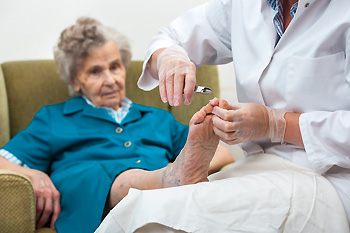Connect With Us
Blog

As people age, elderly foot care becomes increasingly important to maintain mobility and overall health. One of the most essential aspects of foot care is moisturizing, as older skin tends to become drier and more prone to cracking. Applying a gentle foot cream or lotion can help keep the skin soft and prevent issues like calluses or fissures. Proper toenail trimming is also vital to avoid discomfort or infections. Nails should be trimmed straight across and not too short, as cutting too close can lead to ingrown nails. Regular inspection of the feet is important to identify any changes such as redness, swelling, or signs of infection. Wearing well-fitted shoes that provide support can further enhance comfort and prevent injuries, promoting better foot health as you age. If you have noticed any changes in your feet or if you have developed one or more foot conditions, it is suggested that you promptly contact a podiatrist who can treat various foot conditions, and offer practical advice on how to care for your feet.
Proper foot care is something many older adults forget to consider. If you have any concerns about your feet and ankles, contact James Torhorst, DPM from Torhorst Foot and Ankle. Our doctor can provide the care you need to keep you pain-free and on your feet.
The Elderly and Their Feet
As we age we start to notice many changes in our body, but the elder population may not notice them right away. Medical conditions may prevent the elderly to take notice of their foot health right away. Poor vision is a lead contributor to not taking action for the elderly.
Common Conditions
- Neuropathy – can reduce feeling in the feet and can hide many life-threatening medical conditions.
- Reduced flexibility – prevents the ability of proper toenail trimming, and foot cleaning. If left untreated, it may lead to further medical issues.
- Foot sores – amongst the older population can be serious before they are discovered. Some of the problematic conditions they may face are:
- Gouging toenails affecting nearby toe
- Shoes that don’t fit properly
- Pressure sores
- Loss of circulation in legs & feet
- Edema & swelling of feet and ankles
Susceptible Infections
Diabetes and poor circulation can cause general loss of sensitivity over the years, turning a simple cut into a serious issue.
If you have any questions please feel free to contact our offices located in Waupaca and Stevens Point, WI . We offer the newest diagnostic and treatment technologies for all your foot and ankle needs.

Tennis players are at risk for various foot and ankle injuries due to the sport’s fast-paced lateral movements and frequent pivoting. Among the most common tennis injuries are ankle sprains, Achilles tendonitis, plantar fasciitis, and stress fractures. These conditions can result from repetitive impact, poor foot alignment, or sudden changes in direction on hard courts. For example, an ankle sprain occurs when the ligaments surrounding the ankle are overstretched or torn, often after a quick pivot or awkward landing. Achilles tendonitis and plantar fasciitis are overuse injuries that affect the soft tissues in the heel and can lead to chronic pain if left untreated. Stress fractures, which are hairline cracks in the bones, result from repetitive pounding of the feet during play. A podiatrist can use diagnostic imaging to confirm the exact type and extent of the injury. Depending on the diagnosis, medical treatment may include immobilization, custom orthotic support, anti-inflammatory medication, or surgery for more serious cases. If you experience foot or ankle pain after playing tennis, it is suggested that you make an appointment with a podiatrist for an exam, diagnosis, and treatment.
Sports related foot and ankle injuries require proper treatment before players can go back to their regular routines. For more information, contact James Torhorst, DPM of Torhorst Foot and Ankle. Our doctor can provide the care you need to keep you pain-free and on your feet.
Sports Related Foot and Ankle Injuries
Foot and ankle injuries are a common occurrence when it comes to athletes of any sport. While many athletes dismiss the initial aches and pains, the truth is that ignoring potential foot and ankle injuries can lead to serious problems. As athletes continue to place pressure and strain the area further, a mild injury can turn into something as serious as a rupture and may lead to a permanent disability. There are many factors that contribute to sports related foot and ankle injuries, which include failure to warm up properly, not providing support or wearing bad footwear. Common injuries and conditions athletes face, including:
- Plantar Fasciitis
- Plantar Fasciosis
- Achilles Tendinitis
- Achilles Tendon Rupture
- Ankle Sprains
Sports related injuries are commonly treated using the RICE method. This includes rest, applying ice to the injured area, compression and elevating the ankle. More serious sprains and injuries may require surgery, which could include arthroscopic and reconstructive surgery. Rehabilitation and therapy may also be required in order to get any recovering athlete to become fully functional again. Any unusual aches and pains an athlete sustains must be evaluated by a licensed, reputable medical professional.
If you have any questions please feel free to contact our offices located in Waupaca and Stevens Point, WI . We offer the newest diagnostic and treatment technologies for all your foot and ankle needs.

Pregnancy brings many physical changes, and the feet are no exception. As the body adapts to support added weight and shifting posture, the arches may flatten, and swelling can increase. These changes can lead to foot pain, instability, and discomfort with everyday activities. Wearing supportive and properly fitting shoes during pregnancy is essential for maintaining balance and preventing strain on the feet, ankles, and lower back. Footwear with good arch support, cushioning, and a wide toe box can help accommodate changes in foot size and shape. Choosing the right shoes can also reduce the risk of falls and improve overall mobility. If you are pregnant and are experiencing foot pain, it is suggested that you visit a podiatrist who can guide you toward selecting supportive shoes that are right for you.
Pregnant women with swollen feet can be treated with a variety of different methods that are readily available. For more information about other cures for swollen feet during pregnancy, consult with James Torhorst, DPM from Torhorst Foot and Ankle. Our doctor will attend to all of your foot and ankle needs.
What Foot Problems Can Arise During Pregnancy?
One problem that can occur is overpronation, which occurs when the arch of the foot flattens and tends to roll inward. This can cause pain and discomfort in your heels while you’re walking or even just standing up, trying to support your baby.
Another problem is edema, or swelling in the extremities. This often affects the feet during pregnancy but tends to occur in the later stages.
How Can I Keep My Feet Healthy During Pregnancy?
- Wearing orthotics can provide extra support for the feet and help distribute weight evenly
- Minimize the amount of time spent walking barefoot
- Wear shoes with good arch support
- Wear shoes that allow for good circulation to the feet
- Elevate feet if you experience swelling
- Massage your feet
- Get regular, light exercise, such as walking, to promote blood circulation to the feet
If you have any questions please feel free to contact our offices located in Waupaca and Stevens Point, WI . We offer the newest diagnostic and treatment technologies for all your foot and ankle needs.

